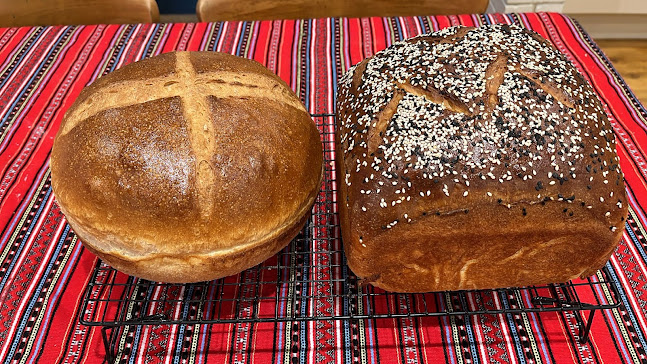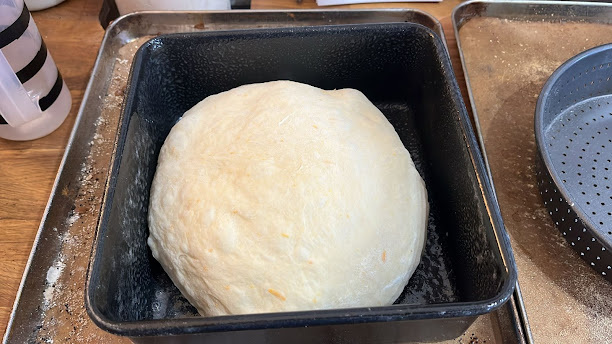Vasilopita (Greek New Year Bread) - Two varieties
Welcome to another step-by-step recipe from BreadClub20. Why not drop by our main Facebook page by clicking here.... If you like what you see and enjoy the recipe, we hope you join us by 'Liking' and 'Subscribing'
In Greece, Eastern Europe and the Balkans, Vasilopita can be a simple dough, infused with herbs or it can made using a sweet, egg-enriched dough or even using a custard base, a galotopita. In parts of Thessaly, it's even a pork-filled phyllo pie.
Our first Vasilopita hails from Pelion, about 300 kilometres north of Athens. It's a thickly-forested area with its own mountain, Pourianos Stavros which rises to 5328 ft above sea level.
The second Vasilopita is from the Balkans and is a richer, more brioche-like dough.
Vasilopita, otherwise known as Vassilis Pie or St. Basil's Pie, is a New Year's Day bread, often containing a coin or a trinket. It's a traditional part of the New Year celebrations but, as with most things, it's now also baked for Epiphany and Christmas.
In Pelion, the bread is marked with the sign of the Cross and cut to celebrate the New Year and to bring luck and good fortune into the household.
Scour the internet and you'll find all manner of varieties - some using a rich, brioche dough, others sprinkled with icing sugar and rich in butter.
So, who was Vassilis, or Basil of Caesarea, as he's often known? He was Bishop of Caesarea Mazaca in Cappadocia, Asia Minor. Born in 330, he died in 379 on the 1st or 2nd of January. he was known for his care of the poor and unfortunate as well as for writing guidelines for monastic life, focusing on liturgical prayer, manual labour and community life.
In Greek tradition, children receive gifts every 1st January, St Basil's Day, and this extends to the kitchen where a Vasilopita is baked and a small coin is hidden inside. symbolic of the fact that St Basil, who came from a wealthy family, gave away all his possessions to the underprivileged, the poor, to those in need and to children.
And, in this spirit, let's bake Vasilopita. Well, let's bake two!
VERSION 1 :
A VASILOPITA FROM PELION
This bread is from a more humble background...it's made with infused basil leaves.
INGREDIENTS
500 gms strong white bread flour
300 gms of lukewarm water
5 gms of instant active yeast or 9 grams of dried yeast
15 gms sugar
15 gms olive oil
10 gms crushed sea salt
1 small egg yolk (beaten)
handful of basil leaves
METHOD
Place the bail leaves in a shallow dish and add the 300 gms of BOILING water. Cover and allow them to steep until the water has become lukewarm and ready for baking. Drain the leaves from the water.
Add a little of the drained water to a bowl, a little of the sugar and the yeast. Stir well and leave it for a few minutes until it starts to froth.
Then add the remainder of the drained water, the flour, the rest of the sugar, the olive oil and the salt.
Mix and then knead until you have a soft and silky dough.
Put the dough in a lightly oiled bowl, cover and place in a warm spot until the dough has doubled in volume.
Tip the dough onto a lightly floured surface. Knock back to remove the air and place a small coin inside the dough. Knead gently for a few seconds and bring them together.
Shape the dough into a boule and place it in a baking tin. Cover and place in a warm spot for about an hour to an hour and a half until it has expanded and doubled in volume. (Watch the dough, not the clock)
Preheat the oven to 190⁰C
Coat the top of the dough with the egg yolk and then form a cross on the top of the dough, going from one edge to the other.
Bake for 30 - 35 minutes on a low rack. The loaf should be golden brown and hollow when tapped on the underneath.
Cool on a rack
The Crumb...
VERSION 2 :
A VASILOPITA FROM THE BALKANS
INGREDIENTS
470 gms strong bread flour (possibly a little more....consider the dough's texture and make your decision)
245 gms warm milk
2 medium eggs
4 gms of crushed sea salt
4 gms instant active yeast
14 gms olive oil
zest of one medium orange
75 gms caster sugar
for glazing
sesame seeds
egg wash
METHOD
Mix the yeast with a little of the sugar and a little of the milk. Leave in a warm place until it starts to froth.
Into a large bowl, add the flour, salt, the rest of the sugar, oil, beaten eggs, the rest of the milk, orange zest and yeast mixture.
Mix and knead until you have a smooth and silky dough. You may need to add a little more flour...judge it for yourself.
Now add a small coin to the dough.
Place in a lightly oiled bowl, cover and place in a warm spot for about an hour, maybe more...until it has doubled in size. Watch the dough, not the clock.
Knock the dough back and knead it once more, very gently. Then form it into a boule and place it in a prepared round or square tin.
Cover once more and allow to rise in a warm place until it has, once more, doubled in size.
Take a sharp blade and mark the surface of the dough with artistic cuts!
Brush the top of the dough with beaten egg wash and sprinkle sesame seeds.
Bake at 190⁰C for 10 minutes and then turn down the heat to 170⁰C for about 30 minutes or until the top is golden brown and hollow when tapped on the underneath.
Cool on a rack.
The Crumb...
And together?
And from the taste-testers?
Happy baking....Happy New Year.
Καλό Ψήσιμο....Καλή χρονιά

.jpeg)



















Comments
Post a Comment